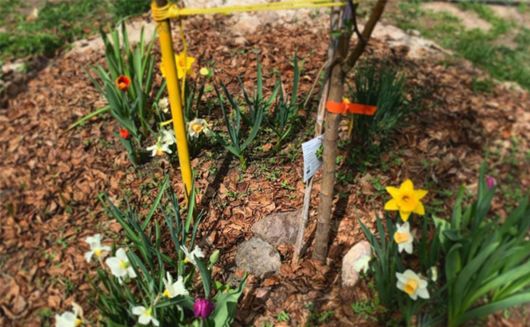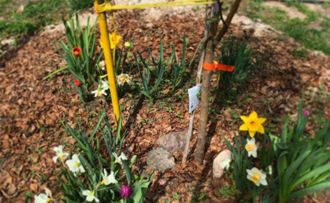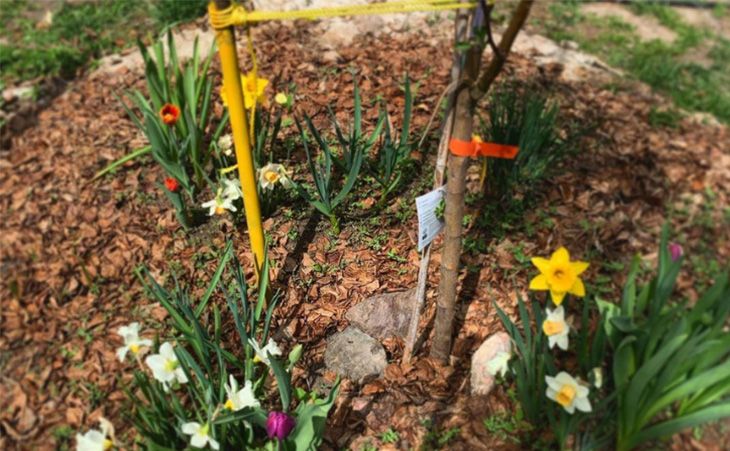How to Build a Permaculture Fruit Tree Guild


What is a Fruit Tree Guild?
A fruit tree guild is a permaculture technique based on natural eco-systems, like what you would find in the forest. A guild is a community of plants that grow and support each other by recycling nutrients back into the soil, providing shade and conserving water, attracting beneficial insects, repelling pests and diseases, building soil, and preventing erosion. You can have a standalone tree guild or link them together with fruit bushes and other trees to form a food forest.
Permaculture principles guide home growers to stray away from conventional orchard rows. Instead, incorporate other edible plants around your tree, ensuring each plant works together for the benefit of the others, for the environment, and for you! Think of it as companion planting taken to the next level.
Benefits of a Fruit Tree Guild
Permaculture gardens and fruit tree guilds are perfect for small spaces. By imitating nature, you promote a healthy eco-system with a variety of productive plants in a garden of any size.
Diversity attracts bacteria, fungi, insects, and birds. Incorporating edibles, medicinal plants, and flowering plants to grow alongside your tree allows those natural processes to take place – which ends up reducing your overall workload in the garden.
Watering is more efficient, due to weed suppression and decreased erosion. In addition, some companion plants may be able to shield your growing fruit tree from sunscald and wind.

Building A Fruit Tree Guild
Don’t be intimidated - just start with your tree and work your way out. Be sure to plant a fruit tree that thrives in your zone. For smaller gardens, choose a dwarf fruit tree or a small berry bush as the central element to your guild. You will want to consider how much space it will need and the shade it will create as it matures when selecting locations for other perennials.
Step 1: Preparing your space
Decide what shape you want your guild. Then, prepare the area around your fruit tree. You can start with a circle around your tree – reaching out to where the canopy of the mature tree’s size will reach. Dig out the grass and weeds of your site. If you want good drainage, consider terracing the ground.
Once your guild has its shape, do a soil test to see if amendments are needed for nutrients. All soils are different. Nutrient levels, which are necessary for plant growth – as well as soil pH, texture, and structure – vary from site to site. It is hard to know what your soil needs without knowing what is there already. Soil tests are the way to find this information.
To give your guild an extra kickstart, consider adding a layer of compost and soil (around 5 inches deep) but keep it away from the tree trunk. Then, add a thick layer of mulch like wood chips.
Step 2: Choosing your plants
There is no single formula for the perfect tree guild, if you see a need in your garden, experiment with different perennials until you find a system that works. Typically, a guild consists of fixers, repellents, attractors, suppressors, mulchers, and accumulator plants.
Nitrogen-fixing plants – Planting “fixers” will be the source of fertilizer for your fruit tree. Fixers refer to plants that are nitrogen-fixing, meaning that they add nitrogen to the soil as they grow. These can be silverberry, goumi, and pretty much any legume (clover, peas, lentils, etc.)
Plants for pollinators and pest control – attracting the right insects can be crucial for the overall health of your fruit trees. Plant flowers as attractors for pollinators and repellers, like garlic that will deter deer and other pests.
Suppressors – suppress the weeds and decrease watering needs with a ground cover – such as strawberries, clover, or mint.
Mulchers & Accumulators - Accumulators rejuvenate soil by pulling up more nutrients. Mulchers, when cut and sprinkled around the tree, hold in moisture and reduce watering needs. The most used plant in permaculture design is comfrey. It is a hardy perennial, easy to care for, and it doubles as a mulcher and an accumulator.

Transforming Your Space
Remember your fruit tree guild or any plant guild can take many shapes. Keep in mind, as your fruit tree grows, your guild will transform and evolve. As your plants mature, you will notice increased yields and plant productivity. Some plants may need to be transplanted due to increased shade. Experiment and find what works in your garden – just don’t forget to grow garden plants that not only help your tree, but those you enjoy growing as well!
With this permaculture method, your fruit tree will be healthy and in the long run, it will save you some time on maintenance. Start building your very own food forest beginning with a fruit tree guild. You will love the natural, lush look of your garden!
A list of helpful plants
- Suppressor Plants: red clover, squash, pumpkins, rhubarb, strawberries, nasturtiums.
- Attractor Plants: edible herbs like fennel, dill, Lavender, and coriander or flowers like salvia, sunflowers, and yarrow.
- Pest Repelling Plants: onions, garlic, daffodils, marigold, oregano, chive
- Accumulators: borage, comfrey, chickweed, yarrow, stinging nettle, strawberries, sorrel, vetch, supine, tansy.
- Mulcher Plants: comfrey, hostas, ruhbarb,
- Nitrogen Fixers: goumi, silverberry, all legumes (clovers, beans, peas, lentils, peas, chickpeas, peanuts, etc.)
- Article Categories:
- Ideas & Inspiration
- Organic Gardening







































